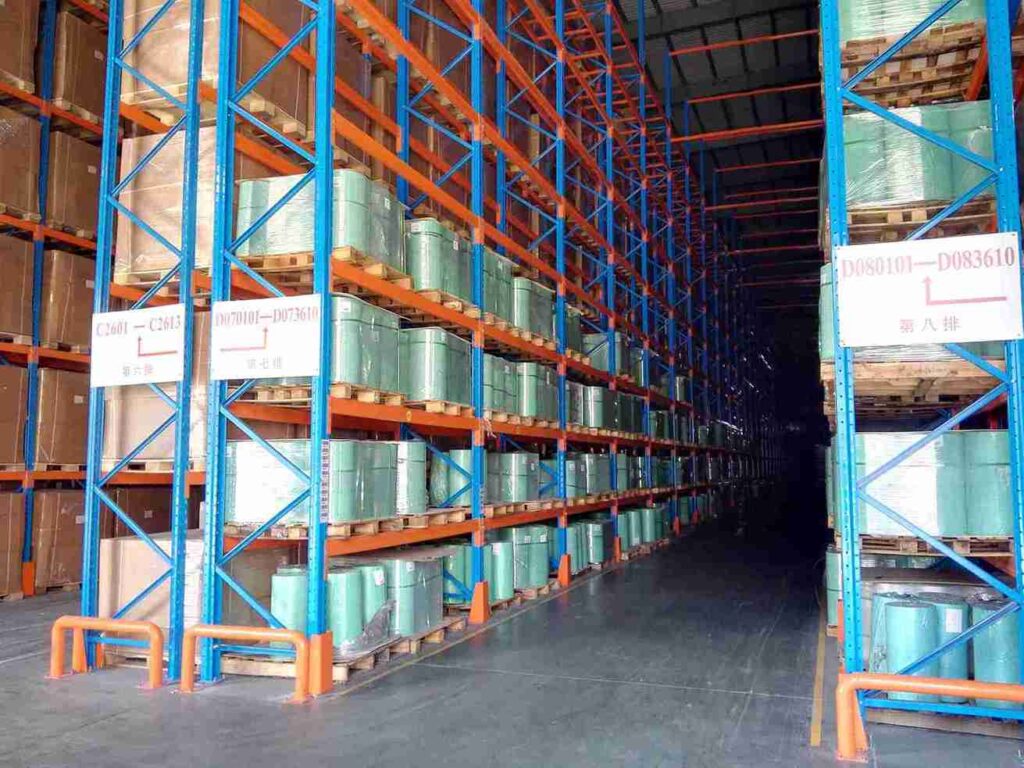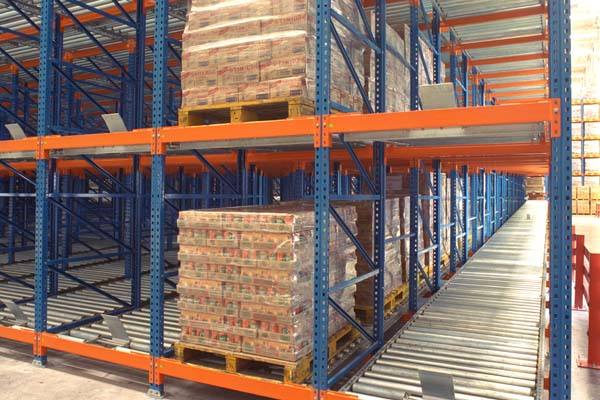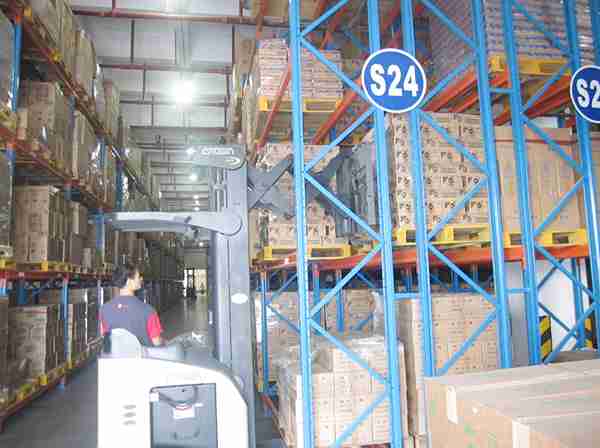📐 "First 50 Enterprise Queries Get Custom 3D Warehouse Design" Plan

Tired of Slow Order Picking? Engineer Peak Efficiency with Heavy-Duty Selective Racking Systems
In the high-stakes world of logistics and warehousing, speed is currency. A slow order picking process is more than an operational bottleneck; it is a direct tax on profitability, a handbrake on growth, and a daily source of frustration. For operations managers and business owners across the dynamic markets of Southeast Asia, the Middle East, Africa, and Latin America, this challenge is amplified by rapid growth and intensifying competition.
The root cause of sluggish fulfillment often lies not with the workforce, but with the foundational storage infrastructure itself. This is where a paradigm shift in thinking is required: selective racking is not merely a passive storage device but an active, engineered component of an efficient workflow. A professionally designed heavy-duty selective racking system serves as the central nervous system of a high-performance warehouse, directly addressing the crippling costs of slow picking and transforming the storage area from a cost center into a powerful engine for revenue generation and customer satisfaction.

Deconstructing the Crisis: The Multi-Layered Impact of an Inefficient Picking Process
To appreciate the transformative power of an optimized storage solution, one must first fully comprehend the true and extensive cost of the status quo. Slow order picking creates a ripple effect that undermines every facet of a business’s operations.
The Quantifiable Financial Drain
The most visible impacts are on the balance sheet. Inefficient picking necessitates a higher labor expenditure to achieve a given output level. This includes not only base wages but also the significant overtime costs required to meet deadlines due to systemic inefficiencies. Furthermore, a constricted picking process places a hard cap on daily order throughput, physically limiting sales capacity and revenue potential. When a warehouse cannot keep pace with order volume, businesses face an impossible choice: enforce long lead times that erode customer loyalty or turn away valuable business entirely.
The Insidious Operational Erosion
Beyond the direct financial metrics lie hidden costs that are more difficult to quantify but equally damaging.
Skyrocketing Error Rates: A disorganized and pressured picking environment is a breeding ground for mistakes. Mis-picks lead to incorrect shipments, which trigger a cascade of costs: reverse logistics, reshipment, inventory reconciliation, and, most critically, irreversible damage to customer trust. The total cost of rectifying a single picking error can dwarf the original profit margin on that order.
The Human Capital Cost: For the warehouse associate, a poorly designed selective racking layout translates to physical strain, wasted effort, and daily frustration. Excessive walking, difficult-to-reach items, and constant searching lead to fatigue, low morale, and high employee turnover. The subsequent costs of recruitment, hiring, and training represent a significant and recurring operational drain, not to mention the loss of experienced, knowledgeable staff.
The Scalability Impediment: As business grows, an inefficient picking system does not scale linearly; its flaws become magnified. A minor bottleneck at a lower volume can become a catastrophic failure point during peak seasons or periods of rapid expansion. Investing in a scalable selective racking system from the outset is a strategic decision that future-proofs the operation against its own success.

Selective Racking Reimagined: The Cornerstone of Modern Warehouse Design
The term “selective racking” is often used generically, but its true engineering significance is what separates a basic storage fixture from a performance-optimized system. At its core, selective pallet racking is defined by its promise of direct, unimpeded access to every single pallet location. This fundamental characteristic is the catalyst for unparalleled efficiency gains.
The “Selective” Advantage: Unlocking Immediate Access
The defining feature of any true selective racking system is its 100% accessibility. Unlike high-density systems like drive-in or push-back racking, there are no pallets stored behind others. Each SKU is available instantly, without the need to move other products. This direct access is the single most critical factor in accelerating order picking cycles. It transforms the storage system into a highly organized library, where every “book” (pallet) has a specific, easily retrievable “address.” This organization is paramount for implementing essential inventory management protocols like FIFO (First-In, First-Out), a non-negotiable requirement for industries dealing with perishable goods, pharmaceuticals, or items with strict expiry dates.
The “Heavy-Duty” Imperative: Engineering for Durability and Performance
Not all selective racking is created equal. The “heavy-duty” qualification signifies a system engineered for the rigors of an industrial environment, built not just to store, but to perform and endure. Key differentiators of a heavy-duty selective racking system include:
Superior Structural Integrity: Utilizing high-tensile steel with a significantly thicker gauge, a heavy-duty selective racking system is designed to withstand dynamic loads, repeated impact from material handling equipment, and the long-term stresses of a multi-shift operation. This robustness is not merely about capacity; it is about maintaining precise alignment and stability over decades of use.
Advanced Connection Systems: The beam-to-upright connection is the most critical safety and performance point in any selective racking system. High-quality heavy-duty selective racking employs features like cold-rolled, teardrop-shaped connectors or bolted connections that create an immensely strong mechanical lock, virtually eliminating the risk of beam dislodgement during forklift impact.
Deflection-Resistant Beams: A hallmark of a professional-grade selective racking system is its attention to load beam deflection. Beams are engineered to resist bending under maximum rated capacity, ensuring pallets can be slid in and out smoothly without catching on the beam below. This seemingly minor detail has a major impact on both operational speed and product damage prevention.

The Mechanics of Speed: How Selective Racking Systematically Eliminates Inefficiency
A heavy-duty selective racking system accelerates the picking process by methodically attacking the primary sources of delay: travel, search, and handling. It is a tool for workflow engineering.
Mastering the Picker’s Journey: The Science of Travel Optimization
Logistics studies consistently demonstrate that travel can consume over half of an order picker’s time. A strategically designed selective racking layout is the primary tool for minimizing this non-value-added movement. The process begins with a meticulous ABC analysis of inventory:
A-Items (High Velocity): These top-moving SKUs are strategically positioned in the “golden zone”—the most accessible areas between knee and shoulder height for manual picking, or in the most fluid paths for forklifts. Placing these items in optimal locations within the selective racking grid is the single most effective way to reduce total travel time.
B & C-Items (Medium to Low Velocity): These SKUs are assigned to higher or lower levels within the selective racking system, logically sequenced to maintain an efficient overall flow. This data-driven zoning ensures that the vast majority of picks are made in the most efficient locations, dramatically increasing picks per hour.
Terminating the Search Mission: Creating a Landscape of Clarity
In a disorganized storage environment, pickers waste invaluable time locating the correct SKU, even when they are in the right general area. A professionally implemented selective racking system, integrated with a Warehouse Management System (WMS), functions with pinpoint accuracy. Every pallet location within the selective racking framework is a unique, clearly labeled address. The picker is directed to an exact, easy-to-identify location, which eliminates hesitation and guesswork, thereby slashing both time-per-pick and error rates simultaneously.
Streamlining the Physical Interface: The Racking-MHE Symbiosis
The interaction between the selective racking system and the Material Handling Equipment (MHE) is a critical determinant of speed. An engineered selective racking layout is designed with this symbiosis in mind.
Precision Aisle Specification: Aisle width is calculated based on the specific turning radius of the client’s forklift fleet. An aisle that is too wide represents a massive, cumulative waste of potential storage space. An aisle that is too narrow creates traffic jams and safety hazards. The optimal aisle width for a selective racking system is a precise calculation, not a guess.
Optimized Vertical Clearances: Beam levels are spaced to provide ample vertical clearance for the specific pallet and forklift tyne dimensions used in the operation. This ensures that pallets can be deposited and retrieved in a single, smooth motion without catching or snagging, preventing the micro-delays that aggregate into significant productivity losses over a full shift.

Beyond Standard Layouts: Advanced Selective Racking Configurations for Elite Performance
While a standard pallet-only selective racking system delivers a monumental improvement, many operations require hybrid solutions to address specific picking challenges. A versatile selective racking framework can be adapted to support these advanced configurations.
Integrating Carton-Flow for Lightning-Fast Case Picking
For operations with high-volume case picking or piece picking requirements, the standard selective racking structure can be seamlessly integrated with carton-flow roller beds. This creates a dynamic pick face where the picker remains stationary, and inventory flows forward by gravity from the bulk storage in the rear. This hybrid model, built upon a selective racking backbone, combines the high-density storage of bulk pallets with the unparalleled speed of a gravity-fed system, dramatically accelerating the picking process for fast-moving SKUs.
The Strategic Foundation for Automation: Building a Bridge to the Future
A heavy-duty selective racking system should be viewed as a long-term strategic asset, not a static purchase. It is the essential foundational grid upon which future automation is built. A properly engineered selective racking system is inherently automation-ready.
AGV and Autonomous Forklift Readiness: These intelligent vehicles rely on perfect consistency and precision to navigate and operate. A heavy-duty selective racking system provides the predictable, unwavering dimensions and structural integrity required for the safe and reliable operation of Automated Guided Vehicles (AGVs) and unmanned forklifts. Any racking deflection or misalignment can disrupt their sensitive guidance systems.
The Logical Precursor to ASRS: The layout logic, inventory zoning, and operational philosophy of a well-planned selective racking system are directly transferable to an Automated Storage and Retrieval System (ASRS). When the business case for full automation matures, the transition from a manual selective racking system to a semi-or fully-automated one is far more seamless and cost-effective, as the underlying storage strategy is already proven and optimized.

Engineered for the Globe: The Uncompromising Standards of Our Selective Racking
Warehouses in Jakarta, Dubai, Lagos, and São Paulo face unique environmental and operational challenges. A one-size-fits-all approach to selective racking is a recipe for failure. Our heavy-duty selective racking systems are engineered from the ground up to exceed international standards, ensuring reliability, safety, and performance in the most demanding conditions.
A Culture of Safety and Seismic Resilience
Safety is the non-negotiable core of our engineering philosophy. Every selective racking system we design is meticulously calculated using state-of-the-art software to comply with and surpass the world’s most rigorous standards, including those set by the Rack Manufacturer’s Institute (RMI) and the European FEM 10.2.02 specifications. For operations in seismically active zones, we perform detailed seismic analyses to ensure the selective racking structure can withstand seismic events, protecting both the inventory and, most importantly, the personnel working within the facility.
Superior Corrosion Defense for Demanding Climates
The humid, salt-laden air of coastal regions and the variable conditions in emerging markets demand superior corrosion protection. Standard paint finishes are insufficient. Our selective racking systems are available with advanced protective solutions, including high-grade electrostatic powder coating and hot-dip galvanization, ensuring the structural integrity and professional appearance of the selective racking investment for its entire operational lifespan.
The Collaborative Blueprint: A Consultative Approach to Selective Racking Design
The most effective selective racking solution is one that is bespoke to the client’s unique operational DNA. This is why the company’s process is fundamentally collaborative, treating each project as a strategic partnership.
Comprehensive Operational Audit: The process initiates with a deep-dive analysis of the client’s business: SKU profiles, inventory velocity, seasonality patterns, current and planned MHE, and specific pain points. This stage is about listening and learning.
Advanced Digital Modeling and Simulation: Leveraging advanced CAD and simulation software, the company’s engineers create a detailed digital twin of the proposed warehouse layout. This model optimizes every aspect of the selective racking placement, aisle configuration, and pick paths. Material flow can be simulated to identify and eliminate potential bottlenecks before installation commences.
Seamless, Phased Implementation: From detailed drawing approval to manufacturing, shipping, and professional installation by certified technicians, the entire project is managed with precision. The goal is to deploy a flawless selective racking system with minimal disruption to the client’s ongoing operations.
Calculating the Return: The Compelling ROI of a Heavy-Duty Selective Racking Investment
Investing in a professionally engineered heavy-duty selective racking system is a capital decision with a clear and demonstrable return. The gains are tangible and directly impact the bottom line:
Labor Productivity: Documented increases in picking speed of 25% to 40% are common, enabling the business to handle significant growth without a proportional increase in labor costs.
Inventory Accuracy: Picking error rates can be reduced to near-zero levels, virtually eliminating the substantial costs associated with returns, reshipments, and customer service remediation.
Space Utilization: Through optimal aisle planning and vertical profiling, storage density within the existing footprint can be increased by up to 30%, deferring or eliminating the need for costly facility expansion or relocation.
Total Cost of Ownership: The extended service life and reduced maintenance requirements of a heavy-duty selective racking system result in a lower total cost of ownership compared to inferior systems that require frequent repair or premature replacement.

Conclusion: Transform Your Warehouse from a Bottleneck into a Competitive Advantage
The question of slow order picking is a symptom of a foundational issue that can no longer be addressed with temporary fixes or increased labor. Persisting with an inadequate storage infrastructure means tacitly accepting elevated operational costs, limited growth capacity, and diminished customer satisfaction as standard business conditions. The definitive solution is to re-engineer the warehouse’s core framework.
By partnering with an industry expert to implement a custom-engineered heavy-duty selective racking system, businesses are making a strategic investment in their most critical operational asset. This decision moves beyond simple storage; it is about installing a proven engine for efficiency, scalability, and profit. It is the decisive step to remove all constraints on growth and to build a faster, smarter, and more resilient logistics operation.
Frequently Asked Questions (FAQs)
Q1: Our inventory is highly diverse, with pallet weights ranging from 300kg to 1,500kg. Can a single selective racking system handle this variation?
Without a doubt. The adaptability of a well-engineered selective racking system is one of its greatest strengths. A custom layout can be designed incorporating beams of different capacities (e.g., lighter-duty beams for upper levels and ultra-heavy-duty beams for lower levels) within the same upright framework. This allows for a perfectly optimized selective racking structure that safely and efficiently accommodates the full spectrum of inventory weights, all within a single, cohesive system.
Q2: What is the typical project timeline from the initial design consultation to a fully operational selective racking system in our warehouse?
While project timelines are customized, a standard timeline for a mid-sized warehouse facility is approximately 8 to 12 weeks. This encompasses 1-2 weeks for final design and client approval, 3-5 weeks for manufacturing of the selective racking components, and 3-5 weeks for shipping and on-site installation by a certified professional team. A detailed and transparent project schedule is provided from the outset.
Q3: What are the critical maintenance and inspection protocols for a heavy-duty selective racking system?
Proactive maintenance is essential for the safety and longevity of any selective racking investment. The company recommends a formal, documented inspection regimen conducted by a qualified expert at least annually. This inspection should thoroughly examine the selective racking for any visible damage, dents, or bends; verify that all beam connectors are secure and safety locks are engaged; check for plumb and alignment of upright frames; and ensure that all protective column guards and end-of-aisle netting are intact. Many clients opt for an annual service contract to ensure this critical upkeep is performed consistently.
Q4: How easily can we reconfigure our selective racking layout internally if our product mix or flow needs to change?
The modular design of selective pallet racking does allow for a degree of in-house reconfiguration, such as relocating beams to different heights on the upright frames to accommodate changing pallet sizes. However, any significant structural changes—such as altering overall aisle widths, adding new rows of selective racking, or increasing the system’s height—must be reviewed and approved by a qualified engineer. This is a critical safety step to ensure the modified selective racking configuration continues to meet all load capacity and seismic stability requirements.
Q5: From a financial perspective, how does the capital outlay for a high-end selective racking system compare to the perpetual cost of operational inefficiency?
This is the fundamental question of value. The initial investment in a premium heavy-duty selective racking system is strategically allocated capital, whereas the cost of inefficiency is a perpetual operational expense. The ongoing drain of slow picking—manifesting in excessive labor, chronic errors, limited throughput, product damage, and safety incidents—continuously erodes profitability. A high-quality selective racking system is an asset that typically achieves a full return on investment within 12 to 24 months through dramatic and sustained operational savings. It is an investment that appreciates by directly enabling growth, while inefficiency is a constant, burning liability.
If you require perfect CAD drawings and quotes for warehouse racking, please contact us. We can provide you with free warehouse racking planning and design services and quotes. Our email address is: jili@geelyracks.com




